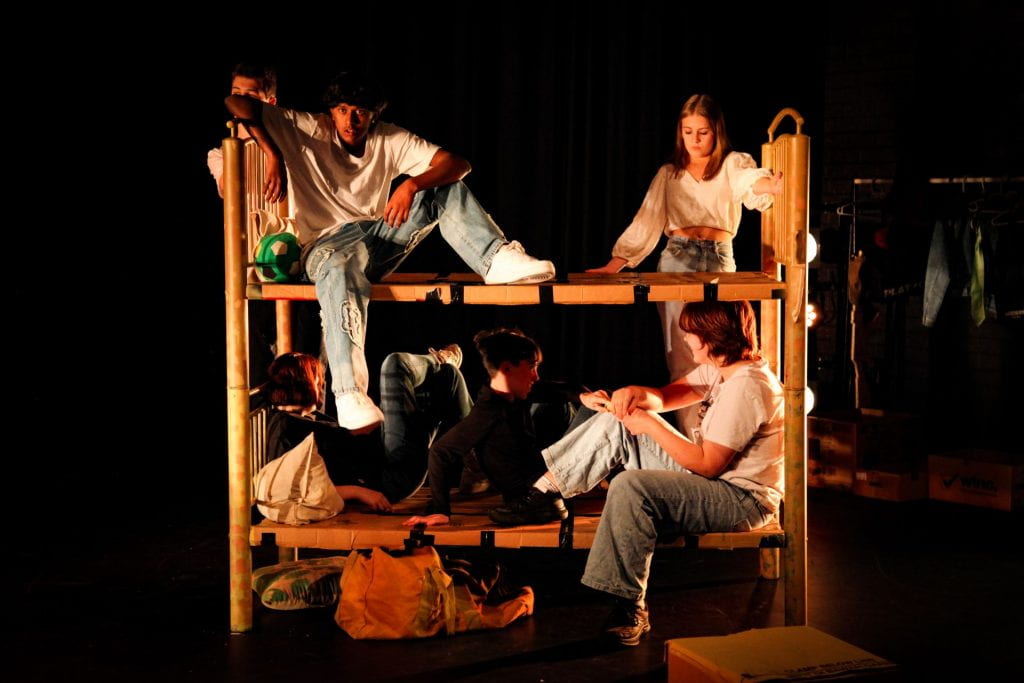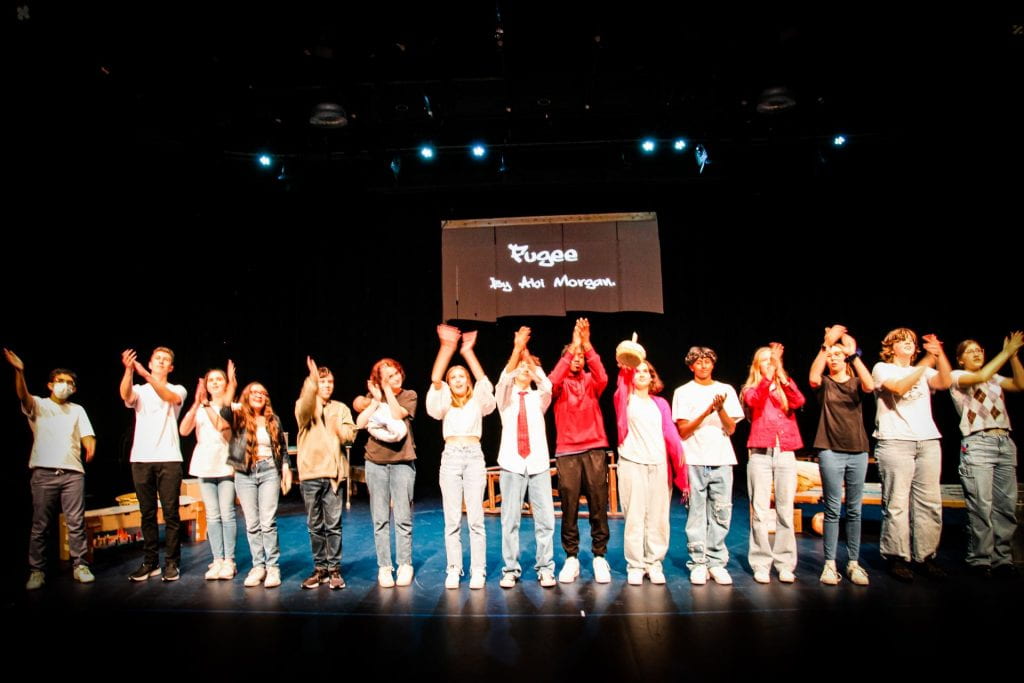Fugee was a play written about refugees and child soldiers. It is telling their story and how hard their life is. It shows how the children lose their innocence and their childhood fighting as a soldier instead of playing games and going to school. This play follows Kojo’s life and shows his journey from being a kid to a soldier then escaping and going to a children’s refuge were he then got age disputed and was deemed an adult where he had to leave and live in a hotel with 11 other men.
Overall vision and impact
Directorial vision
In our directorial vision for Fugee, we wanted to show the hardships of being a refugee, and how that can relate to others’ experiences with pain. We chose to do the show in the upper theatre instead of the CPA because that way the audience feels closer to the cast and can feel more connected. This makes the show more personal. Some of the themes in the show are love, family, friendship, and pain. These are shown in many ways throughout the performance. The theme of love is shown through family and with Kojo and Ara. Throughout the show Ara and Kojo’s relationship grows, it starts as friendship, and over the course of the show, it builds more into love. Love is also shown in Kojo and his family. The themes of family and friendship are shown with Kojo and his family and all the kids at the refuge. All of the kids become his friends and eventually his second family. The theme of pain is also shown from the very start of the show. At the start of the show the dad gets stabbed and throughout the show dies multiple times, showing physical pain. The mental pain showed in Kojo as well as all of the other kids in the refuge because they have all experienced some sort of pain. Being a refugee is very hard and a lot of them would have lost some family as well. This show provides awareness about asylum seekers and child soldiers. The whole story of the show is based on refugees specifically child refugees. As a part of that many children, those that were refugees, where also child soldiers. The story shows all the difficulties of being a child refugee and how the government doesn’t want to deal with them, represented through Kojo getting age disputed and sent out of the child refuge. As well as this it also ventures into his life as a child soldier and how kids should never be forced to do anything like that.
Audience impact
The intended audience impact of this show was to educate the audience about refugees and child soldiers. It was to raise awareness about how hard it is living as a child soldier or a refugee because this information is still very relevant to people in Australia. As well it shows the loss of innocence because the children are forced to act like adults when they are still very young so to them it doesn’t feel like they have a childhood.
We chose to perform it in front of a contemporary audience because this information is still relevant today in countries such as the Congo, Somalia, Syria, and Yemen. These countries still have child soldiers and there are many refugees coming from different countries into Australia.
Set design
We chose to have a cardboard aesthetic to symbolize that everything in the refuge is raw and constantly changing. The cardboard can show how they are constantly moving around because when you move you pack everything in cardboard boxes. It can also show that things can be manipulated and changed (this happens in the show because we use the same prop/set piece as different things such as the ladder which is a door, tree, bench, and shelf). The cardboard can also represent poverty and rough experiences because it is easy to come by. As a part of the costume team, we chose to have white, black, and blue as the base colours, and then have red, yellow, and green as the accent colours. We did this because we wanted to use both ends of the colour spectrum, hence white and black and blue, because we wanted everyone to be wearing jeans. This is because they are very 2000s themed which is when the show is set and because even if they are refugees they would have jeans. We used accent colours to connect different characters together for example we used red to tie the people connected to Kojo together. We chose red to connect people to Kojo because red is the colour of blood. We also chose to have Kojo wear black jeans to show that he is dark and to disconnect him from everyone else and show he is different because everyone is wearing blue jeans so with him wearing a different colour it shows he doesn’t fit in. We also had people such as the social worker, manager, translator, and airport controller officer having a yellow aspect in their costume to tie them together. I think that this is quite effective because it is a visual representation of how people are connected which can help the audience see the connection. For Fugee we chose to do the show in the upper theatre instead of the CPA because that way itis darker and represents the darkness of the show, it is also small so that can show that we feel trapped in. The CPA is quite grand and to do a show like this in that setting would not work with the story. We also chose to have the actors move the set rather than having stage hands because we are all on stage all the time and because we control the world and have to do things for ourselves rather than have others do things for us. We chose to have everyone onstage for the whole show because we are all in the experience together so by not leaving it symbolized that there is no way out. Also even when we werenot a main character on stage we were still helping sell the story and we still had characters to play to show the story.

Reflection
In this show, I was the social worker, girl 1 and apart of the ensemble. I stood up straight and authorially giving me a narcissistic appearance. I projected well because I am the one in charge so I had to be heard over everyone else and my opinion counted more than what everyone else thought. I turned away dismissively from the manager because I was not listening to the fact that she thought Kojo was younger than I thought.
I was prepared for the performance because I knew my lines and I had practiced as much as I could. I focused in class and during the rehearsals. Throughout the performance I think we did well with cutting off peoples lines we did this so it was more realistic and like an actual conversation I think we could have had a bit more movement in our scene because we didn’t move a lot.
The best aspects of our final production were it ran smoothly and the lighting and sound cues were good. Closer the start of us rehearsing it was very hard to remember what scene was next and where we all had to be but as we rehearsed it all we got better at it and got to grips of what the next scene was. All of the lighting and sound cues sounded good and worked well with the show. One thing that needed a bit of improvement was projection because some people wearnt projecting enough and it was hard to hear them. I learned many things about refugees and child soldiers. Next time I would try to add in more movement into my scene because I felt like I was just standing and not moving for most of the scene.
